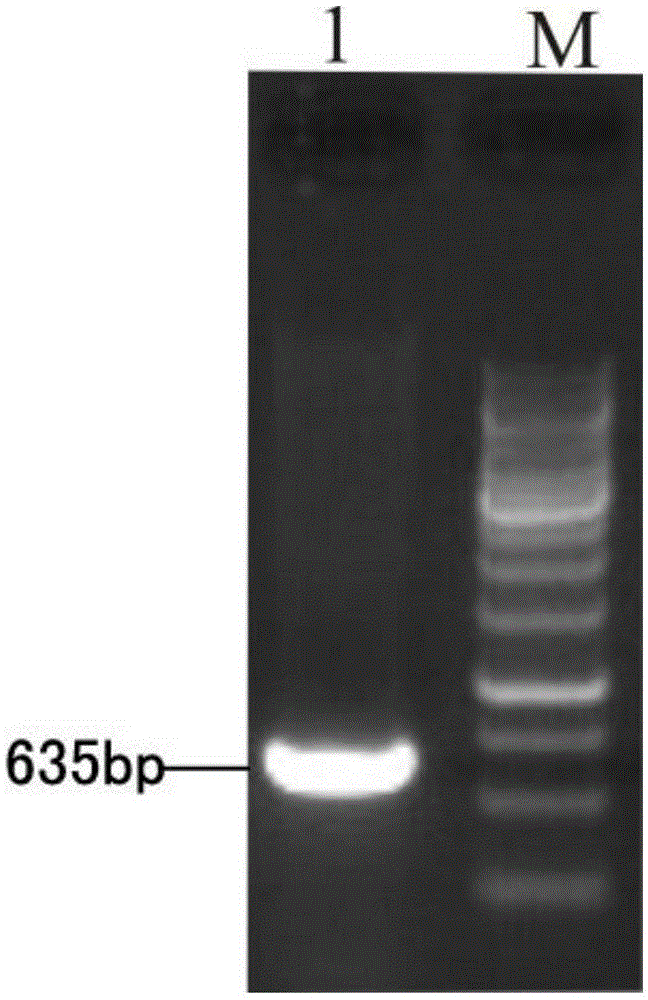Brown planthopper carbonic Anhydrase (CA) gene fragment and its application
A brown planthopper and brown planthopper-resistant technology, applied in the direction of DNA/RNA fragments, application, genetic engineering, etc., can solve the problems of reducing related genes, destroying the conduction tissue of rice plants, and the lethal effect of brown planthopper is not obvious, and achieves the effect of broad application prospects
- Summary
- Abstract
- Description
- Claims
- Application Information
AI Technical Summary
Problems solved by technology
Method used
Image
Examples
Embodiment 1
[0044] The cloning method of embodiment 1.CA gene fragment:
[0045] (1) A total of 50 nymphs of different instars of N. lugens were collected, and the total RNA was extracted by Trziol method.
[0046] 1) Put it into an RNase-free mortar pre-cooled with liquid nitrogen, add liquid nitrogen and grind quickly, grind until powdery and quickly transfer to a pre-cooled 2ml centrifuge tube.
[0047] 2) Add 1ml Trizol, mix gently upside down, and place at room temperature for 5 minutes.
[0048] 3) Add 1 / 5 volume of Trizol (ie 200 μl) of chloroform, shake vigorously for 20 seconds, and place on ice for 3 minutes. Centrifuge at 12,000×g for 15 minutes at 4°C.
[0049] 4) Transfer the upper aqueous phase to another 1.5ml centrifuge tube, and add isopropanol with an equal volume to water. Gently mix the centrifuge tube upside down and let it stand at room temperature for 15 minutes. Centrifuge at 12,000×g for 15 minutes at 4°C.
[0050] 5) Pour off the supernatant, add 1 ml of 75%...
Embodiment 2
[0063] Embodiment 2.dsRNA synthesis and recovery
[0064] (1) According to the CA gene fragment sequence verified by sequencing, primers P3 (SEQ ID NO: 5) and P4 (SEQ ID NO: 6) were designed, and the T7 promoter sequence TAATACGACTCACTATAGGG was added to the 5' end of the upstream and downstream primers. The correctly sequenced pMD18-CA plasmid in Example 1 was used as a template. Primers P5 (SEQ ID NO: 7) and P6 (SEQ ID NO: 8) with a T7 promoter were designed, and the Pmd18-GFP plasmid was used as a template to amplify to obtain a synthetic template of dsGFP.
[0065] Upstream primer (P3):
[0066] 5'-TAATACGACTCACTATAGGGATGGTCGGATTCCACAACATGTTTC-3'
[0067] Downstream primer (P4):
[0068] 5'-TAATACGACTCACTATAGGGCTCACAAACACCTTCCTGTGTCC-3'
[0069] Upstream primer (P5):
[0070] 5'-TAATACGACTCACTATAGGGATGAGTAAAGGAGAAGAAC-3'
[0071] Downstream primer (P6):
[0072] 5'-TAATACGACTCACTATAGGGTTTGTATAGTTCATCCATGC-3'
[0073]Amplification reaction conditions: 94°C, 1min; 94...
Embodiment 3
[0083] Embodiment 3.dsRNA feeding experiment (see Figure 5 )
[0084] (1) Select a glass test tube with openings at both ends and a length of 9.5 cm and a diameter of 2.5 cm as a container for feeding brown planthopper. One end was first sealed with a layer of parafilm, 60 μl of artificial feed was added, and then sealed with a layer of parafilm, so that the added artificial feed was evenly distributed between the two layers of film.
[0085] (2) Insert 30 3rd instar nymphs of the brown planthopper with uniform growth and development, and seal the other end of the test tube in the same step as (1).
[0086] (3) Use black cloth (or opaque material) to protect the test tube with the feed from light, so that the brown planthopper tends to feed on the ends that have been added with artificial feed and sealed with parafilm, and replace with new dsRNA feed every 24 hours. The experiment was carried out in an artificial climate chamber, and the setting conditions were: temperature...
PUM
| Property | Measurement | Unit |
|---|---|---|
| diameter | aaaaa | aaaaa |
Abstract
Description
Claims
Application Information
 Login to View More
Login to View More - R&D
- Intellectual Property
- Life Sciences
- Materials
- Tech Scout
- Unparalleled Data Quality
- Higher Quality Content
- 60% Fewer Hallucinations
Browse by: Latest US Patents, China's latest patents, Technical Efficacy Thesaurus, Application Domain, Technology Topic, Popular Technical Reports.
© 2025 PatSnap. All rights reserved.Legal|Privacy policy|Modern Slavery Act Transparency Statement|Sitemap|About US| Contact US: help@patsnap.com



